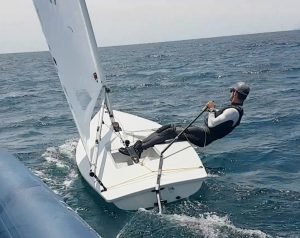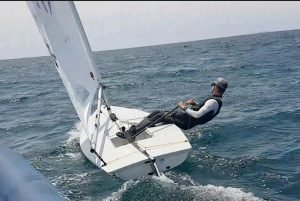Laser Sailing Tips: How to Steer in Waves
Originally published at
International Sailing Academy - Laser Sailing
Fitness can really limit your upwind boat speed when the breeze is up - consistent hiking on windy days can feel truly unsustainable. It’s a constant battle, with thousands of hours required in the gym and on the water to improve fitness. And while hiking may be paramount to upwind speed, there’s a lot of other technique involved that can help you go faster and even make hiking less painful. After all, there are some fast laser sailors who aren’t that fit. So what are they doing anyway that makes them so quick?
This four-part series will get you started.
- They are steering more
- Sail is setup for only 5° of weather helm, and setup with a wide enough groove to accommodate steering for conditions
- They handle gusts and lulls well
- They use their energy efficiently
Steering
Up the face and down the back they say! Simple as that. Well, not really. Good dinghy helming, particularly in waves, is an art so often overlooked by a large number of sailors. At ISA, we spend a lot of time analyzing and correcting steering accuracy, quantity and rhythm. And it isn’t learned overnight. This is true for Olympic athletes training at ISA and for masters sailors alike, all looking to take their performance up a notch.
There are some pre-requisites - setup a balanced boat with not too much weather helm. Set your sail so there’s enough groove to steer to. Be the correct weight for your rig and conditions. Know where close hauled is - and be able to sail it consistently. We can help with these aspects through coaching, some of them are not so easy to accomplish without the right knowledge.
Get an edge with our Performance Clinics
Once these pre-req’s are achieved, sailors can start to “steer” more instead of holding the rudder straight (or worse, cocked up 10° fighting all that helm). What’s the problem with a straight rudder anyway? I thought we were trying to keep it still to reduce drag here? Every coach since the beginning of time has been harping “Don’t use your rudder, use the sails and your body to steer”. They even make you REMOVE your rudder to learn this important skill.
We aim to have the tiller at centerline or crossing centerline when your bow splashes down at the bottom of the wave. This is crucial.
But we do want to steer, quite a bit - WHEN it gets wavy or choppy enough to slow us down and when there’s enough time between waves to steer well. To smash into a wave, even a small one, is to decrease your speed and setup a chain reaction of events that can really hurt performance.
We need to pull our tiller up at the very top of the wave to keep the bow in contact with the wave. Depending on the wave size, this might be a small or large pull - sometimes with the tiller crossing past the outside of the cockpit when viewed from astern.

From here, you stay in contact with the water more instead of flying off that ramp, maintaining a long waterline. This steer down should increase your little bit of weather helm somewhat and want to bring you back up - and almost as soon as you’ve pulled, it’s time to push back. We aim to have the tiller at centerline or crossing centerline when your bow splashes down at the bottom of the wave. This is crucial. If you keep pulling, you’ll have a big stall there and go sideways quick, not to mention, you’ll often get so low in the groove that you’ll become overpowered.

Note in this sequence, the time between these two shots is less than a 1/4 second. You can see the bow splash in the second image and the tiller has just barely crossed center.
Congratulations @sadafba786! You have completed the following achievement on the Steem blockchain and have been rewarded with new badge(s) :
You can view your badges on your Steem Board and compare to others on the Steem Ranking
If you no longer want to receive notifications, reply to this comment with the word
STOPVote for @Steemitboard as a witness to get one more award and increased upvotes!